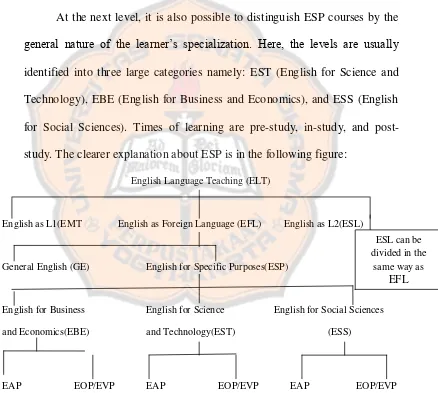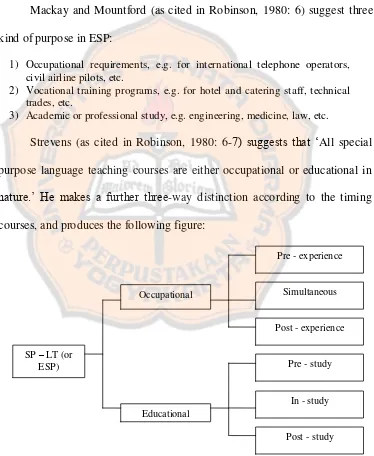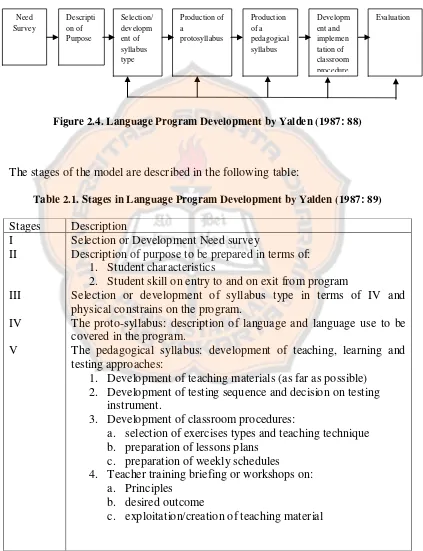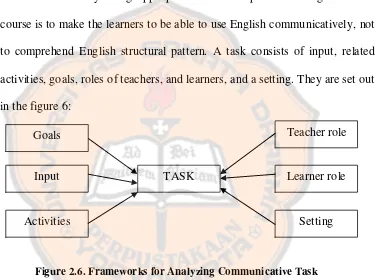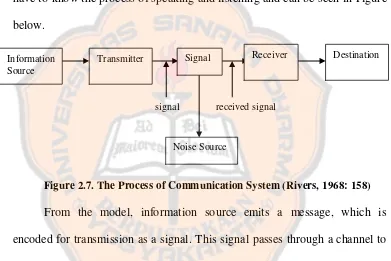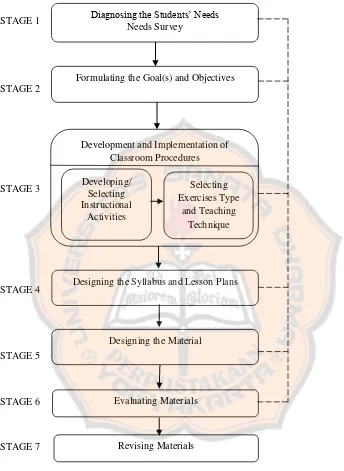Informasi Dokumen
- Penulis:
- Stefani Adelita
- Pengajar:
- Drs. Y. B. Gunawan, M.A.
- Sekolah: Sanata Dharma University
- Mata Pelajaran: English Language Education
- Topik: A Set Of English Instructional Speaking Materials For The Registration And Information Staff Of Panti Rapih Hospital Using Communicative Language Teaching
- Tipe: thesis
- Tahun: 2010
- Kota: Yogyakarta
Ringkasan Dokumen
I. INTRODUCTION
This section introduces the study that focuses on designing a set of English instructional speaking materials tailored for the Registration and Information staff of Panti Rapih Hospital. The background emphasizes the importance of English in healthcare settings, particularly for communicating with foreign patients. The problem formulation outlines two key questions: how the materials are designed and what they look like. The objectives highlight the aim to create effective instructional materials that enhance communication skills among hospital staff. The relevance of the study is underscored by its potential benefits for both staff and English instructors, as it addresses specific needs in a professional context.
II. REVIEW OF RELATED LITERATURE
This chapter reviews the theoretical underpinnings relevant to the study, including English for Specific Purposes (ESP), instructional material design, and communicative language teaching (CLT). The section on ESP discusses its definition, criteria, and classification, emphasizing its focus on learners' specific needs. It explains how ESP courses, particularly English for Occupational Purposes (EOP), cater to professionals like the hospital staff. The instructional material design section explores models by Yalden and Dick & Reiser, providing a framework for developing effective teaching materials. Lastly, the CLT section outlines its principles, emphasizing real communication and the development of communicative competence as central to language learning.
2.1 English for Specific Purposes (ESP)
This subsection defines ESP as a learner-centered approach focused on specific language needs in professional contexts. It differentiates ESP from general English by emphasizing goal-directed learning and the importance of needs analysis. The criteria for an effective ESP course include relevance to occupational or academic needs, which directly applies to the design of materials for hospital staff who require English for patient interactions.
2.2 Instructional Material Design
This section discusses the significance of instructional material design in achieving educational objectives. It reviews models from Yalden and Dick & Reiser, which provide structured approaches to developing teaching materials. The emphasis is placed on the need for a systematic design process that includes needs assessment, goal formulation, and evaluation, ensuring that materials are tailored to the specific context and learners' needs.
2.3 Teaching Speaking using Communicative Language Teaching (CLT)
This subsection elaborates on the principles of CLT, which prioritize interactive and meaningful communication in language learning. It discusses the importance of developing communicative competence through practical speaking activities that reflect real-life situations. The alignment of CLT with the study's objectives reinforces the necessity for the designed materials to incorporate interactive tasks that enhance speaking skills among hospital staff.
III. METHODOLOGY
This chapter outlines the research methodology employed in the study, detailing the research design, setting, participants, instruments, data gathering techniques, and analysis methods. The study utilizes a Research and Development (R&D) approach, focusing on the first five steps of the model to create and evaluate the instructional materials. The needs survey identifies the specific language requirements of the Registration and Information staff, ensuring that the materials developed are relevant and effective in enhancing their speaking skills. The systematic approach to data collection and analysis contributes to the reliability and validity of the findings.
3.1 Research Method
The research method section describes the use of a qualitative approach to gather insights from both staff and instructors. It details how interviews and questionnaires were employed to assess the language needs of the hospital staff and gather feedback on the designed materials. This method ensures a comprehensive understanding of the context and specific requirements, facilitating the creation of tailored instructional materials.
3.2 Research Participants
This subsection identifies the participants involved in the needs survey and the evaluation of the designed materials. It highlights the importance of selecting a representative sample of the Registration and Information staff, as well as instructors from the English Education Study Program, to ensure that the feedback received is relevant and constructive for refining the instructional materials.
3.3 Data Analysis Techniques
The data analysis techniques section explains how qualitative and quantitative data were analyzed to draw meaningful conclusions. The analysis of survey responses and feedback from participants was essential in evaluating the effectiveness of the designed materials and in making necessary revisions. This systematic analysis contributes to the overall quality and applicability of the instructional materials.
IV. RESEARCH FINDINGS AND DISCUSSIONS
In this chapter, the findings from the needs assessment and the evaluation of the designed materials are presented. The section elaborates on the steps taken to design the materials, including diagnosing learners' needs, formulating goals, and developing classroom procedures. The feedback from preliminary field testing is discussed, highlighting the strengths and areas for improvement in the materials. The evaluation results indicate a high level of acceptance among respondents, demonstrating the materials' relevance and effectiveness in meeting the specific needs of the hospital staff.
4.1 The Elaboration of the Steps in Designing the Materials
This subsection provides a detailed account of the process involved in designing the instructional materials. It outlines the systematic approach taken to identify the needs of the learners, set clear objectives, and develop appropriate teaching strategies. The emphasis on a structured design process ensures that the materials are not only relevant but also effective in enhancing the speaking skills of the staff.
4.2 Findings and Discussion on the Designed Materials Evaluation
This section presents the findings from the evaluation of the designed materials, focusing on the feedback received from participants during the preliminary field testing. The discussion highlights the strengths of the materials, such as their relevance to the staff's needs, and addresses any suggestions for improvement. The positive evaluation scores indicate that the materials are well-received and suitable for use in the hospital context.
V. CONCLUSIONS AND SUGGESTIONS
The final chapter summarizes the key findings of the study and offers conclusions regarding the effectiveness of the designed instructional materials. It emphasizes the importance of aligning materials with the specific needs of learners in professional contexts, such as healthcare. The suggestions provided aim to guide English instructors, learners, and future researchers in the implementation and further development of similar materials. The study's contributions to English for Specific Purposes and communicative language teaching are highlighted, reinforcing the relevance of the research in educational settings.
5.1 Conclusions
This subsection summarizes the main conclusions drawn from the research findings, emphasizing the successful design and relevance of the instructional materials for the Registration and Information staff. It highlights the significance of using a needs-based approach in material design and the positive impact of CLT principles on learners' speaking abilities.
5.2 Suggestions
The suggestions section provides practical recommendations for English instructors on how to effectively implement the designed materials in their teaching practice. It also offers guidance for learners on how to engage with the materials to enhance their speaking skills. Additionally, it encourages future researchers to explore further applications of the materials and to conduct studies that build on this research.
Referensi Dokumen
- A Conversation Book I: English in Everyday Life ( Tina Kasloff Carver & Sandra Douglas Fatinos )
- English for the office ( Brendan Moore )
- Domain Five health: Seeing A Doctor ( Margaret Bradshaw )
- Listening and Speaking Introduction Level ( Brigham Young University English Language Center and TALL )
- Listening and Speaking Level 1 ( Brigham Young University English Language Center and TALL )
